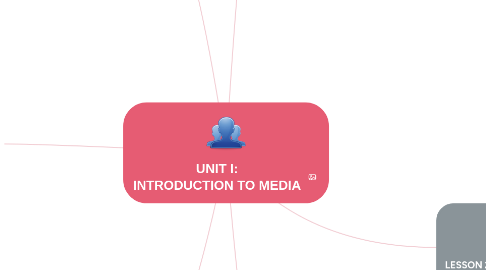
1. LESSON 4: UNDERSTANDING MEDIA: AESTHETICS OF FILM AND TV
1.1. 4.1 The Film Form
1.1.1. Modes of Film Production
1.1.1.1. Pre-production stage
1.1.1.2. Production stage
1.1.1.3. Post-production stage
1.1.2. Film Formats
1.1.2.1. Narrative
1.1.2.2. Documentary
1.1.2.3. Animation
1.1.2.4. Experimental
1.1.3. Film Image Composition
1.1.3.1. The relationship of objects and people
1.1.3.2. The play of light and dark
1.1.3.3. The colors and their patterns
1.1.3.4. The position of the camera and the angles used to frame the subjects
1.1.4. Motion Framing Concepts
1.2. 4.2 The TV Broadcast
1.2.1. Kinds of TV Shows
1.2.1.1. Informative Programming
1.2.1.2. Entertainment Programming
1.2.2. TV Show Anatomy and Advertising
1.3. 4.3 Crafting Media Messages
1.3.1. Creating Meaning in Audio Production
1.3.2. Creating Meaning in Image Production
1.3.3. Creating Meaning in Audiovisual Production
2. LESSON 5: UNDERSTANDING MEDIA: AESTHETICS OF NEW MEDIA
2.1. 5.1 Deconstructing New Media
2.1.1. New Media Technology: Convergence and Characteristics
2.1.2. New Media as Multimedia
2.1.3. New Media Transitions: from Synergy to Transmedia
2.2. 5.2 Intersecting Traditional Media and New Media
2.2.1. Journalism + Internet = Blogging
2.2.2. Broadcasting + Internet = Podcast
2.2.3. Film + Internet = YouTube
2.3. 5.3 Transitioning Media, Transitioning Users
3. LESSON 6: UNDERSTANDING MEDIA: AESTHETICS OF SOCIAL NETWORKING
3.1. 6.1 Deeper Understanding of Social Media
3.1.1. What is Social Networking?
3.1.2. Kinds of Social Media and its Varying Uses
3.1.3. Print-based
3.1.4. Audio-based
3.1.5. Photo-based
3.1.6. Video-based
3.1.7. Social Networking Sites
3.2. 6.2 Relevance of Social Media in Today's Society
3.2.1. Personal Communications
3.2.2. Business and Customer Care Tools
3.2.3. Social Services and Governance
3.2.4. Educational Tools
3.2.5. Advocacy Campaigns for Social Change
3.2.6. Traditional Media Coverage and Social Media Enhancement
3.2.7. Entertainment Portals
4. LESSON 1: WHAT IS MEDIA?
4.1. 1.1 Defining Media
4.1.1. The Communication Process
4.1.1.1. Shanon-Weaver Model of Communication (SMCR Model)
4.1.1.1.1. sender
4.1.1.1.2. message
4.1.1.1.3. channels
4.1.1.1.4. receiver
4.1.2. The Feedback Mechanism
4.1.2.1. based on SMCR Model
4.1.3. Media as an Information Industry
4.1.3.1. Film industry
4.1.3.2. Broadcast industry
4.1.3.3. Publishing industry
4.1.3.4. Photography industry
4.1.4. Media as a Culture of Entertainment
4.1.4.1. based on culture of a nation
4.2. 1.2 Kinds of Media
4.2.1. Traditional Media
4.2.1.1. Print media
4.2.1.2. Broadcast media
4.2.1.3. Film or cinema
4.2.1.4. Mass communication
4.2.2. New Media
4.2.2.1. Computer technology
4.2.2.2. any kind of information and communication technology (ICT) products
4.2.2.3. Mobile technology
4.2.3. Social Media
4.2.3.1. Internet-maintained computer programs
4.2.4. Mobile Communications Technology
4.2.4.1. Smartphones
4.2.5. Related and Emerging Technologies
5. LESSON 2: MEDIA THEN AND NOW
5.1. 2.1 Brief History of Media
5.1.1. Pre-industrial Age
5.1.1.1. Oral traditions
5.1.1.2. Writing symbols
5.1.1.3. Drawing crude pictures
5.1.1.4. Clay and stone tablets
5.1.1.5. Woodblock printing
5.1.2. Industrial Age
5.1.2.1. Use of electricity
5.1.2.2. Evolution of factories
5.1.2.3. Print media
5.1.2.4. Photography
5.1.2.5. Telegraph and telephone
5.1.2.6. Radio system
5.1.3. Electronic Age
5.1.3.1. Gadgets and devices
5.1.3.2. Fax machine
5.1.3.3. Cellular phones
5.1.3.4. Cable and satellite technologies
5.1.3.5. Transportation
5.1.4. Digital Age
5.1.4.1. Computer system
5.1.4.2. Improved version of past inventions
5.2. 2.2 Brief History of Philippine Media
5.2.1. Pre-colonial Traces
5.2.1.1. Ancient Philippine Alphabet: baybayin or alibata
5.2.2. The Print Industry and Filipino Freedom
5.2.2.1. Books, magazines, and newspapers brought to the country by the ancient colonizers
5.2.3. The European Film Import
5.2.3.1. Lumiere brothers
5.2.4. The Broadcast Industry
5.2.5. Local Online Media
5.3. 2.3 The State of Media Today
5.3.1. From Globalization to Glocalization
5.3.2. The Local Landscape
5.4. 2.4 Media Ownership
5.4.1. Mainstream Media
5.4.1.1. commercial-run type of media businesses
5.4.1.1.1. telegraph and telephone system
5.4.2. Alternative and Independent Media
5.4.2.1. the other choice for the existing mainstream media
5.4.3. Community Media
5.4.3.1. any form of media that is created and controlled by a community
5.4.4. State-owned Media
6. LESSON 3: UNDERSTANDING MEDIA: AESTHETICS OF THE IMAGE, TEXT, AND AUDIO
6.1. 3.1 Framing and Reading
6.1.1. Newspapers and Journalism
6.1.2. Books, Comics, Magazines, and the Publishing Industry
6.1.3. Photography and Timeless Image Concepts
6.1.3.1. recording images through a chemical interaction
6.1.3.2. the government owns and controls specific media outlets
6.2. 3.2 Framing and Listening
6.2.1. Radio and Evoking Imagination
6.2.1.1. reaches a wide array of areas
6.2.1.2. uses frequency transmitters
